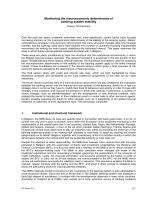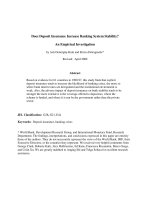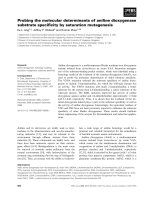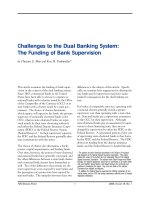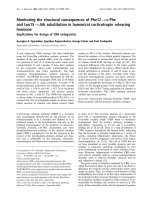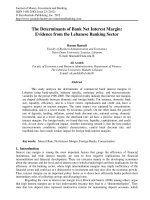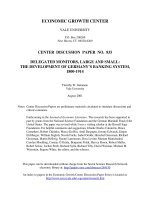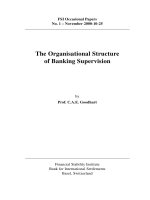Monitoring the macroeconomic determinants of banking system stability
Bạn đang xem bản rút gọn của tài liệu. Xem và tải ngay bản đầy đủ của tài liệu tại đây (127.93 KB, 21 trang )
BIS Papers No 1
117
Monitoring the macroeconomic determinants of
banking system stability
Thierry Timmermans
Over the past few years, prudential authorities and, more specifically, central banks have focused
increasing attention on the macroeconomic determinants of the stability of the banking system. Banks'
vulnerability to changes in the economic environment, the many structural changes within the financial
markets, and the banking crises which have recently hit a number of countries (including industrialised
economies) are among the main factors underlying this enhanced interest. This paper examines the
ways in which these macroprudential analyses are dealt with in Belgium.
These ways are partly conditioned by both the structural and the institutional environments in which
the Belgian financial system operates. This general framework is examined in the first section of this
paper. Notwithstanding these special national features, the theoretical foundations used for analysing
the macroeconomic determinants of the stability of the banking system apply to the entire financial
market. Those foundations are reviewed in the second section, which gives a brief overview of the
economic literature devoted to the determinants of financial crises.
The third section deals with credit and interest rate risks, which are both highlighted by these
theoretical analyses and considered as the most traditional components of the risks run by credit
institutions.
The fourth section examines risks of a more structural nature which are also created by the interaction
between the banking sector and the financial and real spheres of the economy. Banks do in fact run
strategic risks in so far as they have to modify their lines of behaviour and activity in order to cope with
changes in the economic and financial environment in which they operate. Furthermore, a number of
recent changes, such as disintermediation and the development of new financial products, have
enabled the banks to transfer part of their traditional credit or market risks to other economic agents,
thereby possibly exposing the banks to other hazards, such as a weakening of the global financial
resilience of customers or even reputational risks. The last section concludes.
1. Institutional and structural framework
In Belgium, the NBB does not have any specific brief in connection with bank supervision. It is not, of
course, the only one in such a situation, since within the European Union prudential monitoring is the
responsibility of the central bank only in six countries, namely Italy, Spain, the Netherlands, Portugal,
Ireland and Greece. However, in four of the six other member states (Germany, France, Austria and
Finland) the central bank does have to play an important role, either by providing the chairman of the
banking supervisory body or by making staff available to that body, or again by carrying out certain
assignments on its behalf. Belgium, together with Luxembourg, is the EU member country in which the
demarcation between the central bank and the prudential authority is most clear-cut.
Despite this absence of direct responsibility, the NBB does however have various links with the body
entrusted in Belgium with the supervision of banks and investment undertakings, the Banking and
Finance Commission (BFC). It is thus laid down that a member of the NBB is an ex officio member of
the BFC’s decision-making body. The Bank is also consulted when changes are made in the
prudential regulations and the accounting principles governing the presentation of the accounts of
credit institutions. Lastly, the financial information and accounts provided by the banks in order to
enable the BFC to carry out its off-site analysis are communicated to the BFC via the NBB, which
carries out verifications and performs validation tests in advance. This procedure enables the Bank to
maintain regular contacts with the banks and the BFC, and gives it direct access to statistical data
which are particularly useful for macroprudential analyses.
The NBB’s relatively limited involvement in the monitoring of the banking system is also attributable to
more structural causes. Since the end of World War II, the Belgian banking system has displayed a
fairly high degree of soundness, in contrast with the developments observed in many other countries.
According to Lindgren et al (1996), who carried out a fairly extensive survey of banking problems
118
BIS Papers No 1
recorded between 1980 and 1996, 140 countries, including 24 OECD member states, have
encountered such difficulties. Belgium is one of only five OECD members not to appear on this list.
This favourable development is attributable to a significant extent to the very structure of the activities
of the Belgian banking sector. Owing to the high level of general government borrowing, public debt
securities represent a very large proportion of the assets of credit institutions. Thus, about 40% of the
Belgian banks’ claims on resident sectors have general government as their counterparty; the
corresponding average percentage for Germany, France, the United Kingdom and the Netherlands is
only 11%. Conversely, the claims vis-à-vis companies and individuals, which carry higher risks,
represent 58% in these four countries, against 39% in Belgium.
This favourable development is attributable to a significant extent to the very structure of the activities
of the Belgian banking sector. Owing to the high level of general government borrowing, public debt
securities represent a very large proportion of the assets of credit institutions. Thus, about 40% of the
Belgian banks’ claims on resident sectors have general government as their counterparty; the
corresponding average percentage for Germany, France, the United Kingdom and the Netherlands is
only 11%. Conversely, the claims vis-à-vis companies and individuals, which carry higher risks,
represent 58% in these four countries, against 39% in Belgium.
Table 1
Breakdown of assets of credit institutions by resident sector
(outstanding amounts at end-1997, percentages of total assets vis-à-vis resident counterparties)
Belgium Germany France Netherlands
United
Kingdom
Average of
the 4 latter
countries
1
Individuals 18.9 30.1 20.3 40.3 41.4 33.0
Companies 20.5 20,0 24.5 35.7 19.8 25.0
General
government
40.9 16.7 10.2 15.3 2.9 11.3
Credit
institutions
19.7 33.2 44.9 8.7 35.8 30.7
Total 100.0 100.0 100.0 100.0 100.0 100.0
1
Unweighted average.
Sources: ECB; NBB.
Intermediation of the abundant financial savings of households in order to finance general government
therefore still constitutes one of the major traditional functions of Belgian banks. They have been able
to play this role by succeeding, through active use of their distribution network, in placing their own
bonds with individuals at the expense of direct subscriptions for public securities.
This favourable structure must not of course be used as an excuse for an attitude of benign neglect to
problems of a macroprudential nature. Moreover, the pressure of events is making itself clearly felt at
this level. The challenges faced by the banking sector do not spare Belgian banks, nor are these
sheltered from the contagious effect on their domestic market of accidents originating in other
countries.
The management of the many banking crises which have occurred in recent years has, furthermore,
focused attention again on the essential contributions which central banks can make, whatever their
role in the microprudential field, to containing systemic risks.
The first is the adoption of a clearly defined objective of price stability, which is the best guarantee of
financial stability, since such an environment reduces uncertainties and eliminates one of the
fundamental causes of distortion in financial choices.
The second is the devising of reliable and efficient payment mechanisms. Such mechanisms ensure
rapid and transparent transmission of monetary policy, but also make it possible to prevent the
breakdown of a payment system or the default of one of the participants from bringing about a
disruption of all the financial markets.
BIS Papers No 1
119
A third role which central banks may have to play in the event of the outbreak of a financial crisis is
that of lender of last resort. Owing to the many types of interaction which take place nowadays
between markets, the possible causes of systemic risks have become more numerous and the
potential consequences of individual incidents more unpredictable.
In this context, the concepts of individual problems and temporary liquidity difficulties are no longer
sufficient, on their own, to mark out with certainty the limits to the last-resort interventions of central
banks. It is therefore vital for the latter to carry out regular analyses and adequate monitoring of the
overall stability of the financial system.
In this field, the NBB is in a rather privileged position, owing to the very important role which it plays in
the collection, analysis and dissemination of statistics in Belgium. In addition to its intervention,
mentioned earlier, in the processing of the financial accounts submitted by the banks, the NBB is also
charged with the administration of the Central Register for Credits to Enterprises and to Individuals
and of the Central Balance Sheet Office, which collects the standardised accounting statements which
have to be filed by all Belgian non-financial enterprises. It also conducts business surveys and is
responsible for the balance of payments and foreign trade statistics. Lastly, it is the Bank that draws
up, on behalf of the National Accounts Institute, the national accounts data, not only for the financial
part but also for the real economy.
These various sources of information enable the Bank to supplement the analyses made by the BFC.
While the latter adopts a kind of bottom up approach by grouping together the data concerning the
individual banks to obtain an overall view of the entire banking sector, the NBB takes a top down view
by examining the implications of major macroeconomic developments for the operation of the financial
markets in general and the stability of the banking system in particular.
The spectacular expansion in the volume of financial transactions compared with that of real activity
has, moreover, led the Bank to examine the link between these two spheres of the economy from a
new angle. While it is of course still essential for a central bank to carry out a very close examination
of the effects which changes in financial conditions produce on the real part of the economy, largely
via the process of transmission of monetary policy, the financial system has, conversely, become more
vulnerable to developments in the real sphere. This trend therefore makes it necessary to reverse the
direction of the analyses by studying to what extent macroeconomic developments of a real nature can
affect the stability of the financial system.
2. Theoretical outline of the determinants of financial crises
Problems of a systemic nature, which can affect the whole of the banking sector, have been the
subject of various theoretical analyses. Attempting to clarify the mechanisms of development of such
risks, these analyses seek to draw lessons on the warning signs of financial crises. A first subsection
deals with the more traditional approaches, namely the purely empirical works, demand-based
explanations and monetarist-type analyses. A second subsection presents the more recent theory of
asymmetric information, which places the emphasis more on the specific situation of credit institutions.
2.1 The traditional approaches
In the absence of strict definitions of the concept of financial crises, many analyses covering this
phenomenon adopt an essentially empirical approach based on circumstantial data and episodes (for
instance, Kindleberger (1978)). This viewpoint has several deficiencies. By concentrating on the actual
crises, it fails to account for risks which, while potentially destabilising, have been successfully
confined by preventive action. Furthermore, empirical studies often lead to the attribution of any
excessive volatility on financial markets to a systemic problem. They may thus lead to the choice of an
excessively wide range of indicators. Conversely, by ignoring the logical links between the various
constituent elements of a financial crisis, they may fail to take account of phenomena which, though
unspectacular, nevertheless play a central role in the way a crisis develops.
Two rather different theoretical approaches, the Keynesian and monetarist lines of argument, have
tried to lessen the shortcomings of empirical analysis. The former attributes the origin of financial
crises to a decrease in demand. According to this school of thought, the assessment of financial risks
120
BIS Papers No 1
should therefore take account mainly of the development of the components of aggregate demand,
measured either directly or, preferably, via indicators which are more readily available.
While the course of the business cycle certainly does exert an influence on the stability of the financial
system, not every recession phase is accompanied by a systemic crisis. Conversely, a worsening of
systemic risks is not always preceded by a slackening of activity, but may on the contrary trigger a
cyclical turnaround.
The monetarists, for their part, attach only moderate importance to the cyclical variables, because they
tend to analyse the economy from the angle of monetary developments. Thus, they trace the starting
point of the financial crisis of the 1930s back to the rise in interest rates triggered at the end of 1928 by
the Federal Reserve. The 1930 banking crisis, which in their opinion is the central element of the
propagation mechanism of this crisis, is thus regarded as an essentially monetary phenomenon,
because it was reflected in a cumulative decrease in the monetary multiplier. In the absence of a
sufficiently expansionist monetary policy, the money supply therefore decreased rapidly, leading to
recession.
By reducing the elements explaining financial crises to monetary factors alone, some monetarists go
so far, at the extreme, as to deny the existence of a systemic risk applying exclusively to banks.
Kaufman (1986), for instance, claims that the latter are not intrinsically more fragile than non-bank
enterprises, and that the risk of contagion resulting from a possible bankruptcy is not greater. This
approach obviously greatly narrows the scope of the argument, even though it has the indisputable
advantage of giving prominence to the role of monetary stability in maintaining financial system
soundness.
Table 2
Synoptic table of the main approaches to financial crises
Approach
Source of financial
crises
Main advantages of
the approach
Main drawbacks of the
approach
Preferred indicators
Essentially
empirical
approaches
Sources identified in an ad
hoc manner, often by
reference to the depression
of the 1930s
Simplicity. Episodes close to
on-the-ground reality.
Recreate the historical and
the socio-economic
environment
Concentrates on crises
which have actually
occurred, failing to consider
potential crises
Very wide-ranging sets of
indicators
Keynesian
approach
Insufficient global demand Stress on the cyclical
factors which constitute a
major determinant of
financial crises
Neglects the non-cyclical
causes of financial crises
Aggregate demand and its
components, or more
rapidly available indicators
Monetarist
approach
Financial crises always
have a monetary origin
(inadequate development of
monetary aggregates or
inappropriate interest rates)
Emphasis on the
importance of monetary
stability
Neglects the intrinsic
causes of fragility of banks.
Financial crises too
restrictively defined
Interest rates, monetary
aggregates, interbank
market liquidity, etc
Asymmetric
information
models
Problems of adverse
selection (poor choice of co-
contractors) and moral
hazard (harmful behaviour
of co-contractors)
The main factors
aggravating the moral
hazard or adverse selection
are the deterioration of
repayment capacities, the
rise in real interest rates and
the volatility of asset prices
Strict definition of financial
crises
Very structured theoretical
foundations, well suited to
the banks’ intermediation
activity
Approach essentially
centred on market and
credit risks
Fails to consider the crisis
factors which do not
intensify the asymmetric
information problems
Solvency and liquidity of
companies, households and
banks
Nominal and real interest
rates
Inflation rates
Share and bond prices and
exchange rates (affecting
guarantees)
Source: NBB, Economic Review, May 2000.
2.2 The asymmetric information models
The aim of the asymmetric information models is to remedy the shortcomings of the traditional
economic approaches. Contrary to empirical analysis and, to a lesser extent, to the demand-based
approach, which is more cyclical in essence, these models in fact propose a strict definition of the
BIS Papers No 1
121
phenomenon of a financial crisis. Moreover, their analysis framework is considerably less restricted
than that of the monetarist approach.
The asymmetric information approach furthermore draws attention to phenomena of discontinuity in
intermediation activity, whereas traditional economic theory is characterised by its marginalist line of
argument and by the concept of equilibrium.
Ultimately, the management of the credit risk associated with information asymmetries is central to the
banks’ intermediation activity, while the knowledge which they accumulate concerning the profile of
their borrowers constitutes their main comparative advantage with respect to the securities market.
Information asymmetry may take two forms which are often referred to in insurance theory, namely
adverse selection and moral hazard. Very briefly, adverse selection refers to perverse mechanisms of
choice of co-contractors or partners which lead to a biased risk structure. A moral hazard exists when
an inadequate incentive structure induces a contractor to involve himself, after the conclusion of the
contract, in activities which are liable to impede the successful progress of that contract.
Economists such as Mankiw (1986) and Mishkin (1991) have put forward the concept of asymmetric
information to explain the occurrence of financial crises. In their view, moral hazard and adverse
selection may, beyond a certain level, lead to a break in the intermediation channels, as these two
phenomena may greatly obscure the information available to the banks on the quality of debtors. This
may lead to a veritable rationing of credit, which may be damaging to the most solvent debtors even
when they are willing to put up with interest rate conditions which are profitable for credit institutions.
This is, moreover, the kind of situation which Mishkin (1991) refers to in his definition of a financial
crisis: “financial crisis is a disruption to financial markets in which adverse selection and moral hazard
problems become much worse, so that financial markets are unable to efficiently channel funds to
those who have the most productive investment opportunities”.
By analysing the anatomy of various US financial crises, Mishkin draws attention to three categories of
indicators which have often coincided at the beginning of a financial crisis. These are the worsening of
the ability to repay loans, the rise in real interest rates and the volatility of asset prices.
The first factor fits directly into the framework of the banking profession. Owing to the special
relationships which they maintain with their customers and thanks to their accumulated expertise,
credit institutions have a decisive comparative advantage as regards credit risk management, which
enables them to lessen the problems of asymmetric information. This advantage may, however,
lessen if the environment becomes more unstable.
A rise in real interest rates constitutes the second factor of financial instability identified by Mishkin.
This fundamental determinant operates at two levels. On the one hand, higher real interest rates can
be borne only by borrowers whose investment projects are sufficiently profitable. This substantial
degree of profitability is generally coupled with an increased risk profile. On the other hand, the most
reliable borrowers are the victims of obvious discrimination when the banks, as a result of their inability
to evaluate individual risk profiles, impose uniform borrowing conditions on their customers. By
exacerbating this discrimination, a rise in the real rate will induce the most solvent operators to leave
the market.
The third indicator, namely an increase in the volatility of asset prices, is more akin to market risks. Its
influence is exerted via loan guarantees, the existence of which makes it possible to lessen the
problems of moral hazard and adverse selection. An erosion of the value of guarantees, which
constitute the penalty associated with default, becomes less of a deterrent when this guarantee loses
some of its value. Furthermore, it reduces the protection enjoyed by banks against credit risks.
The banks are not only potential victims of moral hazard and adverse selection. They can also derive
an advantage from these mechanisms. In the event of difficulties due to a deterioration in their
customers’ repayment capacities or a fall in the market value of their securities portfolio, some banks
may be tempted to engage in riskier activities in a sort of “gamble for survival”.
Similarly, the banks’ perception of the existence of an implicit guarantee owing, for instance, to the
principle of “too big to fail”, or possibly an excessively generous deposit guarantee system, might
induce some credit institutions to give preference to excessively risky investments.
Lastly, identical mechanisms of moral hazard and adverse selection are liable to extend the problems
originally created by individual institutions to the entire banking sector. Firstly, depositors, who are
generally unable to differentiate between credit institutions according to their solvency, will be induced
to make massive withdrawals of their deposits, even from sound banks, for fear of being the victims of
122
BIS Papers No 1
adverse selection. Secondly, the existence of chains of claims and debts between financial institutions
might accentuate the moral hazard if it strengthens, within the banking sector, the assumption of an
intervention by the lender of last resort.
3. Credit and interest rate risks
3.1 General framework
As indicated by the review of the economic literature in Section 2, theoretical analysis of the
determinants of financial crises took a long time to free itself from its close links with traditional
macroeconomic analysis, whether Keynesian or monetarist in spirit. The great merit of the asymmetric
information approach is the focus on the factors that set credit institutions apart from other sectors of
activity.
This indisputable progress in the theoretical approach has not perhaps been sufficiently accompanied
as yet by parallel progress in empirical measuring instruments. This dichotomy might have a number
of different explanations. Firstly, financial statistics remain in several respects less developed and less
harmonised than real statistics, especially as regards data on outstanding amounts. Financial flows
are often difficult to trace and are subject to sharp fluctuations. While the annual flows of real
transactions vary within narrow limits, changes in stocks measured by the financial accounts are liable
to jump suddenly from strongly positive balances to strongly negative ones.
This situation leads to a second difficulty. Capital movements are more difficult to predict and model.
While there are a number of global and integrated real models, financial models are often more
restricted in scope. They are generally confined to the transactions which are most directly relevant for
the transmission channels of monetary policy and only very rarely apply to the problems of the stability
of the financial sector.
Lastly, macroprudential analysis probably requires certain changes in perspective. On the one hand,
as already indicated above, the traditional analyses which examine the impact of financial
developments on the real sphere must be coupled with an approach which studies the implications of
real developments for the soundness of the financial sector. On the other hand, the developments to
be detected are no longer exposed just to gradual changes but may also reflect sharp deteriorations,
since systemic crises are characterised by a discontinuity in intermediation activity.
In this context, sophisticated instruments such as financial stability models or composite indices are
not as yet widely available. Macroprudential studies are still largely based either on balance sheet
analysis techniques applied to the accounts of credit institutions or on the macroeconomic indicators
which are most directly connected with banking activity.
Belgium is no exception and still relies on this traditional approach. The risk indicators presented
below are eclectic and limited. They do not aim to lead to an overall assessment of the stability of the
Belgian banking sector, which is not the subject of this paper. They confine themselves to briefly
illustrating some advantages and limitations connected with the use of a few indicators by dealing
successively with the risks connected with credits to enterprises, credits to individuals and interest rate
positions. The emphasis is on the macroeconomic data which can supplement the data derived from
the financial accounts of credit institutions.
3.2 Risks on credits to enterprises
The risks run by banks on their credits to enterprises will depend, on the one hand, on the
development of the outstanding amounts of these credits on the assets side of the balance sheet and,
on the other, on the lesser or greater probability of their suffering losses on these assets.
However, the rates of change in bank credits to companies, as they appear in the statements of
account of credit institutions, provide only a very sketchy picture of the development of companies’
financing requirements. As is shown by the data of the Central Balance Sheet Office, bank credits
represent less than 20% of the financing sources of Belgian enterprises. This is not, incidentally, a
situation unique to Belgium. It is much the same in the other EU countries, as can be seen from the
BIS Papers No 1
123
BACH file in which the European Commission groups together the data concerning the annual
accounts of enterprises in nine member states.
The fact that this proportion is small is not attributable, in Belgium any more than in the other countries
of the Community, to a large growth in issues of fixed interest securities, the outstanding amount of
which is still very small in Europe for non-financial companies. The share of equity capital has
increased in a favourable stock market climate, but the main point to be noted is that over 40% of
financing resources come from other (intragroup, commercial, payroll, tax, etc) debts.
An analysis and follow-up of the financing transactions carried out between enterprises in the form of
intragroup credits or commercial credits is thus seen to be a necessary supplement for the monitoring
of banking or market financing transactions. How do the big multinational groups manage their
financial flows and spread their risks? What are the payment periods granted by or imposed on
enterprises? Do these periods change over time according to the size of the enterprises or depending
on the business cycle?
An analysis of the probabilities of default or of the risks of losses carried out on the basis of the banks’
accounting data will have to rely chiefly on the development of provisions, supplemented where
appropriate by an examination of risk concentrations. However, these data are not always easy to
aggregate and often necessitate an individual approach.
In particular, provisions are generally formed by banks on a case by case basis when objective signals
appear or as a result of specific events which point clearly to a worsening of the risk on a particular
credit. They are rarely envisaged as a regular charge to be covered in advance according to expected
losses. This conception deprives the provisions indicator of much of its predictive value.
The development of credit risk management techniques should lead to major developments in this
field. It is also a sphere in which the use of macroeconomic data, particularly those of the Central
Balance Sheet Office, might contribute not only to a better analysis of macroprudential stability but
also to an improvement of the risk provision procedures advocated by the microprudential authorities.
Another statistical source, the Central Register for Credits, makes it possible to produce a sectoral
breakdown of bank lending to enterprises, which is not generally possible on the basis of the banks’
financial accounts.
This sectoral breakdown is, for Belgian banks, fairly close to that of the sectors’ shares in total value
added. This distribution of risks by types of activity is accompanied by a high degree of spread among
enterprises. As the Belgian economy consists chiefly of SMEs, the average amounts of the bank loans
contracted by enterprises do not reach an outstanding amount of 1 million euros in any sector.
The Central Register for Credits also provides an item of information which is at first sight less
reassuring. The coverage ratio of interest charges (net operating result plus financial proceeds in
relation to financial charges) is low, indeed less than unity in several sectors. This situation reflects the
tendency of a large number of enterprises, particularly SMEs, to close their accounts near to break-
even for tax reasons.
This behaviour is illustrated by the percentage of enterprises which have suffered losses,
independently of the size of these negative results. This percentage has fluctuated between 35 and
45% since 1990.
While this indicator throws little light on the average profitability of Belgian enterprises (this is more
appropriately measured by the profitability of equity capital), it does highlight the problems of data
quality. The data of the Central Balance Sheet Office constitute a useful supplement to those of the
banks’ financial accounts, but they are also much less reliable.
The gaps and weaknesses still displayed by the accounts published by many non-financial companies
continue to be one of the major sources of asymmetric information between borrowing enterprises and
their lenders. The banks, owing to their special relationships and their bilateral contacts, endeavour to
reduce this asymmetry, but obviously without being able to eliminate it entirely.
124
BIS Papers No 1
Figure 1
Indicators of financial soundness of companies
84 85 86 87 88 89 90 91 92 93 94 95 96 97 98
0
20
40
60
80
100
86 87 88 89 90 91 92 93 94 95 96 97 98
8
9
10
11
12
13
14
15
16
50
55
60
65
70
75
80
1.8
2.4
0.8
0.8
1.6
1.3
1.3
1.4
2.9
0.6
312.3
171.0
379.3
535.5
629.6
138.8
265.2
200.8
947.0
104.1
100.0
18.2
14.1
10.0
8.5
1.9
14.1
5.7
25.9
1.6
100.0
9.8
14.3
9.4
7.0
2.4
23.2
5.1
24.6
4.2
Agriculture
Total
phd00-9a
1.1 Development of the financing structure
of Belgian companies
(percentages of total)
1.2 Indicators of the profitability of Belgian
companies
(percentages)
Equity capital
Credits from Belgian banks
Other financial debts
Commercial debts
Other debts
Profitability of equity capital (left-hand scale)
Percentage of enterprises showing a profit
(right-hand scale)
Loans
contracted as
percentage of
total credits
Value added
as percentage
of total
Coverage ratio
of interest
charges
Industry
Building
Trade
Hotels and catering
Transport and communication
Real estate
Other services to enterprises
Other services to households
Average amount
of loans contracted
in thousands
of euros
Fixed interest securities
1.3 Analysis of the sectoral breakdown of bank credits to Belgian companies at end-1999
Sources: Gerling Namur; NAI; NBB.
3.3 Risks on credits to individuals
The risks connected with the granting of credits to individuals are, in a number of respects, different in
nature from those resulting from loans granted to enterprises.
Firstly, the average amount of credits per borrower is much smaller. The distribution of total credits
over a larger number of debtors leads to greater diversification of risks and, furthermore, a very large
proportion of the outstanding amount of borrowings is covered by mortgage guarantees. Secondly, the
management of the risks connected with credits to individuals can be standardised to a greater extent,
since the uncertainty factors liable to undermine the situation of this category of debtors are less
numerous than in the case of credits to enterprises. Thirdly, losses on credits in the event of an
